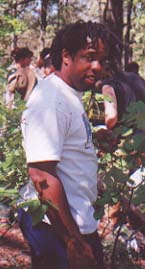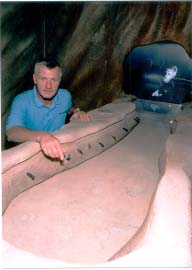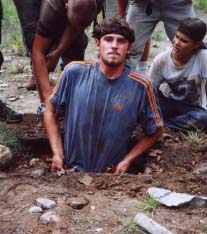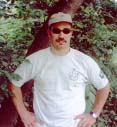 |
|
 |
|
|
Home →
Publications →
True Tracks →
Summer 2000
|
True Tracks - Summer 2000
|
|
|
 |
| |
|
Victor Wooten Combines Tracking With Music
By Dan Hirshberg
When Grammy award-winning musician Victor
Wooten looks at a trail of tracks on the ground, he reads more than just
the imprints of an animal or person. He envisions a piece of music. In
fact, when the bassist plays music, he often relates it with nature.
"There is a definite relationship," says Wooten,
who has taken several Tracker School courses. "The same tools you
learn in Tracker School, such as tracking, inner vision
and awareness, can be transpired into other things. For me, that's music."
In the fall, Wooten is holding a bass camp for
musicians near his home in Tennessee. He plans on incorporating many of
the Tracker skills he has learned into the camp's course curriculum.
"There is a rhythm to
the tracks," says Wooten, who plays with Bela Fleck & The
Flecktones, selected by the Reader's Poll in Playboy Magazine as this
year's Best Jazz Group. "How can we relate the rhythm of tracks
to music? That is what we will strive to do. I want to expose some of
these musicians to some of the stuff Tom teaches. I want them to
touch on inner vision and relating that to music."
In what promises to be a very interesting camp,
participants are going to be treated to a two-fold lesson plan: music and
basic wilderness survival skills.
"We're going to
approach music through nature," says Wooten. "Not only are they
going to learn music skills, but we'll break it up. A music lesson,
then outdoors skills."
When Wooten first attended a Tracker School class, he
knew a lot about music, and very little about the wilderness.
 |
Victor Wooten at
Search & Rescue class |
In 1991, Wooten read one of Tom's books and in 1992
took his first class. He admits now that he'd "never done any
camping before (the class). I had never really been in the outdoors before. But
I was always interested."
In preparation for his Standard, Wooten went to a
nature park a few days before the start of class at 4 in the morning, "just
to say that I'd been outside for a night."
Indeed, Wooten has come a long way since. He loves
the outdoors and spends as much time as he can outside. Although
he frequently tours around the country, he comes to as
many classes as he can manage. In May he attended Search and Rescue.
"It's a great time," Wooten says of Tracker
School. "I've learned so many amazing things." And now he's looking to pass on
that knowledge to others through the art of music. For more information about
Victor Wooten, see his website: www.victorwooten.com. |
| |
|
| |
|
2001 Schedule features 3 new classes
The 2001 Tracker School schedule,
which was released earlier this month, features three new classes.
"Prophecy" is slated for two different weeks, Jan. 28-Feb. 3 and April 22-28.
Tom noted, "Since I began to teach the Philosophy Workshops over 15 years ago,
I've always wanted to include a class on Prophecy. This new class will enter
Grandfather's world of Prophecy, how he arrived at these prophecies and how to
interpret them. Yet this class will go far beyond Grandfather's prophecies and
enter the many other related prophecies found throughout the world. I will teach
the Visionary and Spiritual language necessary to interpret any prophecy, while
teaching you how to enter your own personal world of prophecy. This ability to
see into all the probable and possible futures is not a gift, but can
be
learned and used in a very real and vital way." Philosophy I Workshop is the
prerequisite.
"The Way of the Scout" is scheduled for Oct. 7-13. The Way of the Scout will
fill a void that has not been addressed in the Scout, Advanced Scout, Scout
Philosophy or the Expert Scout classes. It will not only cover in great detail
the many teachings that were only brushed over in all of these other classes,
but go far beyond what you have already been taught. This class is the real
science behind the invisibility and power of the Scout. It will enter the world
of high speed and invisible survival, the higher levels of Scout awareness,
Scout tracking and counter tracking, as well as the art of raiding, warfare and
psychological warfare used by the ancient Scouts. This class will deepen your
understanding and awareness of Scout life and
philosophy. Scout is the
prerequisite.
"The Way of Grandfather" will be held Jan. 21-27. According to Tom,
"Originally I was inclined to call this class Grandfather II, but after
reviewing all of the information that I wanted to pass onto my students, I feel
that this class will stand alone. Unlike the Grandfather class, this class will
delve deeply into Grandfather's daily life, his teachings, rituals, ceremonies,
higher levels of awareness and the various stories, parables and spiritual
teachings that he passed on to me. The application of these teachings will go
beyond the wilderness and into you're everyday life." The prerequisite is the
Standard class.
|
| |
|
| |
|
Apache Tracking/Tom Brown Featured in a New Museum
Exhibit
By Maureen McConnell |
| |
|
"I never thought I'd see my name in an exhibit." Tom
Brown Jr. said to his Search and Rescue class in May. He had just returned
from the press opening of Natural Mysteries, a new permanent exhibit at
the Museum of Science in Boston, where he was the featured speaker.
"You come into this cave and see these mountain lion
tracks," he said. "There's a screen above the tracks and there's Tom Brown
in a window in this cave! It looks like I'm there pointing out the tracks,
talking about Grandfather. All of a sudden, my wildest dream comes true
... when I fade to black suddenly the surface of the Plexiglas is lit from
overhead and the mountain lion is projected. You can look through the
animal at the resulting track to see the pressure releases getting built."
The tracks Tom described are the actual preserved tracks
of Katy, a 5 month old mountain lion from the Southwick Zoo in Menden,
Massachusetts. Last fall, in preparation for the Apache tracking component
of our Natural Mysteries exhibit, she walked through a tracking box filled
with a dry sand-cement mix while being filmed from above. Immediately
after the tracks were made, the tracking box was misted with water to set
the cement and preserve the pressure releases. In the finished exhibit,
the video of the cat is projected upon its own trackway.
Tom was filmed this spring in his living room at the
farm, "interpreting" the tracks as if they had been laid down by a
mountain lion walking into a cave. "I have a moral dilemma about this
filming," Tom said to the crew before the video shoot. "Nothing this cat
does is natural. It's extremely nervous because it's freaked out by the
cameras and lights. It's not familiar with the substrate, so it scratches
and sniffs. I can make up a scenario to match the trackway - that this cat
is nervous because it's entering the cave for the first time, but I don't
want people saying that Tom Brown faked tracks for this museum exhibit."
 |
Tom points to mountain lion tracks at museum exhibit.
In the background, note Tom's hologram. |
Not to worry. Visitors have been riveted by the mountain
lion footage and seem impressed by the depth of the Apache system of
tracking.
Tom has helped the scientific community on several
occasions, often without his contribution being credited. In my opinion,
the recognition he receives in this science museum exhibit is long
overdue. Maureen McConnell is a tracker student and an exhibit
planner at the Museum of Science in Boston, Massachusetts.
|
|
|
|
| |
|
Committing Yourself to Tracking
By Jerry Mundy, with Dan Stanchfield
Recently during a break at Search and Rescue, Jon
Young and Kevin Reeve were pondering the question, "How many days it would take
for a person to reach the ability of `Dead' tracking?"
That is the ability to follow any trail to its end before the person on the
other end is dead. The simple solution to the question was to ask for volunteers
who would be interested in a self-study commitment of 30 days, 8 hours a day, of
just tracking. Kevin and Jon would like to thank everyone who expressed interest
in this venture. In an effort to speed the process along, the pilot concept was
put into the hands of Dan Stanchfield and myself.
The idea at this moment is for the two of us to discover the highs and lows
of this process of learning on our own and to offer advice through our
experience to others. Given time with the process, other groups will form for
the same sort of experience. Ultimately Kevin and Jon are looking to find the
best process for improving the training of highly motivated individuals and
groups for the purpose of fulfilling Tom's dreams for a nationwide circuit of
Tracker search and rescue teams. So please be patient while the process is
hashed out.
So what do Dan and I have in the form of advice for starting to fulfill this
passion on your own? Good question.
Find people with your passion who can support you in the field. Tracking
alone can be great, but with another person to tell you when you are wrong, it
can be even better.
There is only one way to get better - track and acknowledge your own
weaknesses. Oops, I guess that is actually two ways. Anyway, find the people,
get outside with as large a block of time as you can (ten days straight if you
can swing it would be a great start), and find your walls. The easiest way to do
this is by having your tracking partner lay down a mile long trail and then you
track it (finding every single track) over a maximum of two days. This will
teach you what your walls are and thus give you the direction you need to head
to overcome them.
Remember all walls may not be just the next track. Quick answer: Why ten
days? Because conceptually you start with a mile long test and after ten days
you retest the mile to see how you are progressing.
Now focus on exercises you have learned through classes to get over these
walls. Dan and I have spent whole days just `pick' tracking a single track,
drawing what we see in intense details just to help us learn a substrate. It is
not easy, especially with ticks crawling all over you in intense heat and
humidity. But this is the only way to get better.
Our schedule in a day consists of getting up at 4-4:30 a.m., attending to a
morning sit, listening to bird language and concentric rings, journaling the
sit, doing wisdom of the marks and wisdom of the breaks then have some breakfast
and out the door to whatever exercise we can conceive of to get us over our
walls.
Great resources are Tom Brown's The Science and Art of Tracking and Field
Guide to Nature Observation and Tracking. Simply read these and highlight any
hint of an exercise you could do to help you become a better tracker. Spend all
day out there tracking. Get back in camp soon enough for another set of
`wisdoms,' an evening sit, and journaling until you wake up the next morning
drooling in your notebook (we try to be in bed by ten for at least six hours of
sleep). It is that easy and that hard. Some days we do well and some days we do
not so well. We will try and offer better advice next time around.
Good Tracking. |
| |
|
| |
|
|
| |
|
| |
|
Tracker student "survives" on Survivor Show
If you've been watching CBS
TV's hit summer show, "Survivor," and wondering if that blonde-haired
contestant, Greg Buis, looks familiar, he may be more familiar than you think.
Buis, of Colorado, was one of 16 individuals vying for a $1 million prize on
a remote island off the Malaysian coast. Buis is no stranger to survival
situations. He is a Tracker student and may have been one of your classmates
during a Tracker course.
In the Survivor show format, the participants must work together in teams to
survive, but every three days they hold secret ballots to expel a fellow
contestant. The last one "standing" wins the $1 million prize. Sixteen
participants were initially selected.
While it may not be a true survival situation, contestants have
eaten rats on the rat-infested island. Buis, in fact, trapped a rat with a trap
design that is taught in the Advanced Standard. |
| |
|
| |
|
Search and Rescue Class Offers Unique Tracking Skills
By Kevin Reeve
The Search and Rescue class provided Tom with the
opportunity to pass along many skills he's never taught before and brought
to reality his dream of teaching a class that meets the needs of SAR teams
as well as police investigators.
There were two main themes of this class. One was
developing the skills necessary to conduct a high speed tracking search
for a lost individual. This included pre-track research and logistics, the
first hours on the scene, the actual track following, first-aid for the
victim once found, and many other details surrounding a lost person track.
The students learned many skills, including interviewing
family members, speed tracking and track cutting. Perhaps the biggest
learning experience for the group came from the complicated process of
tracking team dynamics. The teams learned to be part of a larger search
effort and encountered the complexities of their own group dynamics.
The second main theme of the class delved heavily into
the intensive forensic analysis of a crime scene, including excavating a
body, and tracking a crime scene. The level of detail necessary to be
effective in this type of tracking was a big surprise to everyone. We were
looking for minute clues in soil excavated from a hole, and by tedious
work, the class was able to find everything the instructors had planted
many months before.
All skills were brought to play in a final exercise
Friday when the class conducted a series of lost person searches to locate
people lost in the maze. The results were impressive, amusing, and
surprising and many important lessons were learned. Many students came
away with a strong desire to form tracking teams in their respective areas
and to work hard on improving their SAR tracking skills. |
| |
|
| |
 |
Sam Grimes slides into a scout pit
during the Teen Scout class at this year's Coyote Tracks
program. The first two weeks featured programs for
teens, with families (and another teen class) enjoying
the last two weeks. |
|
| |
|
| |
|
Tracker School wins awards
True Tracks was an award-winning entry in two recent
media contests.
The Tracker School's newsletter received third place
honors in the newsletter category from both the North Jersey Press Club
and the Working Press Association of New Jersey.
Additionally, a press release about former caretaker
Marion Chappel garnered a first place plaque from the North Jersey Press
Club and third place from the Working Press Association.
Tracker School publicist Dan Hirshberg submitted the
entries. |
| |
|
| |
|
New Instructors
The Tracker School has added two new instructors to its staff, former
Navy SEAL Rodney Dickey and Pine Barrens caretaker Bill McConnell. Rodney brings
a wealth of experience to Tracker School after serving with the SEALS for five
years (eight years overall in the Navy) while McConnell has been living in the
Pine Barrens for nearly a year.
"Rodney and Bill each bring a new dimension to our team of instructors," said
Tom Brown, Jr. "I am confident that they will do a great job for us and that our
students will appreciate their knowledge and teaching expertise."
Rodney and his wife Kim recently had a baby girl, Cynthia Gabriel.
Congratulations!
Welcome aboard Rodney and Bill!
|
| |
 |
Rodney Dickey |
|
| |
|
| |
|
Stanchfield leaves Tracker School to pursue a dream
By Dan Hirshberg
Dan Stanchfield always dreamed of becoming a Navy SEAL, but for one reason
or another, he wasn't able to pursue that dream.
"It was a long-time dream of mine," he said. "But I got talked out of it
early on."
However, in the winter, the veteran Tracker instructor realized he could
still go after that dream and decided to leave the school in the spring to
pursue that goal.
"From a very young age I've always wanted to become a warrior," the
California native said. "Not for the adrenaline of it, but more to protect
others.
They're (SEALs) the best show out there and I want to be among the best. I
want to see what my body can do."
Normally, the 30-year old Stanchfield would not be eligible for the SEALs
since he is past the cutoff age of 28. He was able to get around the cutoff with
a waiver. "I had no idea I could get a waiver," he admitted.
Over the past year, Stanchfield was able to meet a number of SEALs who
attended Tracker School. By talking with them, his interest in joining the SEALs
was sparked again. "These guys were down-to-earth," noted Stanchfield. "They
were a lot different than what I expected."
Officially associated with Tracker School since the Fall of 1995, he served
first as a caretaker in the Pine Barrens for one and a half years. As an
instructor, Stanchfield excelled in many different areas. Teaching was an
experience that Stanchfield cherishes.
"As a kid I would've given a body part if somebody had taught me how to make
a fire or make an arrowhead," said Stanchfield, whose sense of humor is enjoyed
by all. "I tried all that stuff when I was young, but I didn't know what I was
doing. Being able to give people the tools to provide for themselves is a great
feeling. But now it's time to follow my heart in another direction."
Everyone at Tracker School wishes Dan good luck. |
| |
|
| |
|
Obeying The Laws Of Nature
By "Ninja" Joe Lau
Senior Instructor
My sensei, Jack Hoban, once told me a story of when he
was training in Japan with his teacher, Hatsumi Sensei. After training,
they were relaxing and Jack asked Hatsumi Sensei - "How did Takamatsu
Sensei teach you 900 years of martial arts training in just 15 years?"
Hatsumi Sensei answered Jack without missing a beat saying - "I can teach
you in ten! But, you have to listen to what I say!"
I have thought a lot about this teaching/learning
ability. How is it that someone can truly learn such amounts of
information in such short periods of time??!! As a matter of fact, how did
Grandfather download to Tom not only the PHYSICAL SKILLS of almost every
tribe and culture that Grandfather came across in his travels, but also
the PHILOSOPHY SKILLS as well??!! It pretty much took most of
Grandfather's life (60 years of wandering after 20 years of his own
tribe's training) to discover and experience all these skills! How did
Grandfather pass all that to Tom in just ten years?
How is any of this even possible? I believe the
possibility of this even occurring is based on a few important points:
1) The passion of the student: A teacher will only choose
a student who is going to go the distance and listen to what the teacher
says so as to not waste any of their time. Tom was always self-motivated.
Hatsumi Sensei was also that type of student.
2) The ability for a teacher to teach a student how to
teach himself: The teacher knows that they will eventually leave the
student. Tom calls this the "impending exodus." Tom said he never knew
when Grandfather was going to leave, so he worked at listening very hard
to what he had to say. I believe one of the ways of doing this is through
"Coyote Teaching." The teacher teaches the student how to GUIDE himself by
passing on the importance of asking oneself the "Sacred Questions."
3) The ability to explain the skills, whether they are
physical or spiritual, through what I am now calling the "Natural Laws." These laws are universal
principles, meaning they apply to all things, all the time, in all places.
In order for it to truly be called a law, there must be a reward and
penalty system. For example, if PRESSURE is a law for friction fire
making, it is how much pressure that you must apply and for how long
(form/technique) that is the law. If you use too much or too little
pressure, you won't get a fire - you'll be penalized for breaking a law!
If you have just the right amount, for just the right time, you will be
rewarded with a fire. So, what are other laws of friction fire making and
what forms can they take on? There are as many endless variations as there
are environments (hint)! However, as long as you KNOW the laws, you also
know when you are breaking them.
How a student begins to learn is though learning forms.
It's a process. These forms are studied and worked on UNTIL the student
can find and see the "Natural Laws" that CREATE the form or the technique.
This is one of the reasons why the laws are so hard to see. It is because
the FORM keeps CHANGING. So, the trick is not to memorize 900 years of
forms and techniques. That is the hard way and it will take you 900 years
to do it.
A great teacher will teach from what Tom calls the
Shaman's Path. All true shaman finally find and then walk the same path
"up the mountain." It is the many, many trails (forms/techniques) that
lead TO the Shaman's Path (the "Natural Laws") that can be confusing. The
shaman has transcended all culture, all form, all techniques, all
philosophies. All are destined to reach the Shaman's Path provided 1) You
keep going through your passion, 2) Your teacher can show you HOW to keep
going, and 3) Your teacher can show you the "Natural Laws."
Check out "Ninja" Joe's website at
www.naturalduties.com and learn more about Sensei Jack Hoban and
Dr. Robert Humphrey.
"It is our felt need to provide and protect others
because we value their lives more so than our own."
~ Joseph Lau |
| |
|
Please
see the Site Information & Copyright Page
|
|
This website has no official or
informal connection to the Tracker School or Tom Brown Jr. whatsoever |
|
|
 |
|
•
•
•
•
•
•
•
•
•
•
•
•
|
 |
|
|

